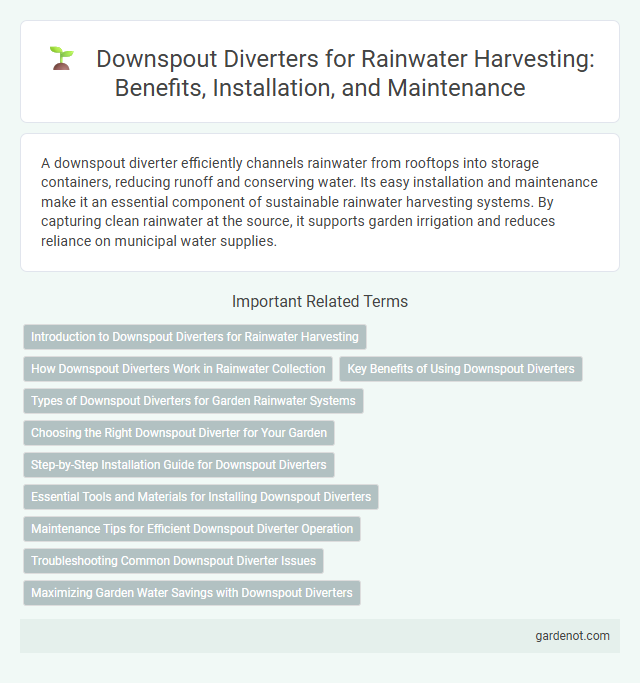A downspout diverter efficiently channels rainwater from rooftops into storage containers, reducing runoff and conserving water. Its easy installation and maintenance make it an essential component of sustainable rainwater harvesting systems. By capturing clean rainwater at the source, it supports garden irrigation and reduces reliance on municipal water supplies.
Introduction to Downspout Diverters for Rainwater Harvesting
Downspout diverters are essential components in rainwater harvesting systems, designed to channel roof runoff into storage containers efficiently. These devices connect to existing gutter downspouts, allowing users to collect clean rainwater while diverting excess flow away during heavy rainfall. Proper installation and maintenance of downspout diverters enhance water conservation and reduce stormwater runoff impacts on local drainage systems.
How Downspout Diverters Work in Rainwater Collection
Downspout diverters channel rainwater from roof gutters directly into storage tanks or barrels by redirecting water flow through a small spout attachment, preventing overflow and debris from entering the storage system. These devices typically feature a filter screen to block leaves and contaminants, ensuring cleaner water collection for irrigation or non-potable use. By automatically switching flow back to the downspout during heavy rain or when the tank is full, downspout diverters protect rainwater systems from damage and maintain efficient water harvesting.
Key Benefits of Using Downspout Diverters
Downspout diverters efficiently channel rainwater from gutters into storage containers, reducing runoff and conserving water for irrigation or household use. They prevent erosion and minimize flooding by controlling water flow away from foundations, protecting property integrity. Easy to install and cost-effective, these devices enhance sustainable water management in residential and commercial settings.
Types of Downspout Diverters for Garden Rainwater Systems
Downspout diverters for garden rainwater systems include manual diverters, automated diverters, and first-flush diverters, each designed to efficiently channel roof runoff into storage containers or irrigation systems. Manual diverters require user intervention to redirect water flow, while automated models use sensors or float mechanisms to regulate water diversion without constant monitoring. First-flush diverters improve water quality by diverting initial roof runoff containing debris and contaminants away from storage tanks.
Choosing the Right Downspout Diverter for Your Garden
Selecting the right downspout diverter for your garden involves assessing your roof's size and the average rainfall in your area to ensure efficient water collection. Opt for materials like stainless steel or durable plastic that resist corrosion and withstand harsh weather conditions for long-lasting performance. Consider diverters with easy-to-clean filters and adjustable flow control to maintain water quality and optimize irrigation for your garden plants.
Step-by-Step Installation Guide for Downspout Diverters
Begin the installation of a downspout diverter by measuring and marking the section of the downspout to be cut, typically about 8 to 12 inches from the ground. Use a saw to carefully cut the downspout, then attach the diverter inlet to the upper portion with screws or brackets ensuring a secure fit for water flow control. Connect the diverter outlet to a hose or pipe leading to the rainwater storage tank, sealing all joints with waterproof tape or sealant to prevent leaks and ensure efficient redirection of runoff.
Essential Tools and Materials for Installing Downspout Diverters
Installing downspout diverters requires essential tools such as a drill, tin snips, screwdriver, measuring tape, and a level for precise alignment. Key materials include the diverter kit itself, flexible hoses, sealant or silicone caulk to prevent leaks, and mounting brackets for secure attachment. Proper preparation with these tools and materials ensures efficient rainwater collection and system durability.
Maintenance Tips for Efficient Downspout Diverter Operation
Regularly inspect and clean the downspout diverter to prevent debris buildup that can obstruct water flow and reduce efficiency. Ensure seals and connections are tight and free from leaks to maintain proper water redirection into the storage system. Periodic lubrication of moving parts and checking for corrosion extend the lifespan and optimal performance of the diverter.
Troubleshooting Common Downspout Diverter Issues
Common downspout diverter issues include clogging from debris such as leaves and dirt, causing water flow blockage and inefficient rainwater collection. Regular inspection and cleaning of filters and screens prevent overflow and ground erosion by ensuring smooth redirection of water into storage tanks. Leaks often occur due to loose fittings or cracked components, which can be sealed with waterproof tape or replaced to maintain system integrity and optimize rainwater harvesting efficiency.
Maximizing Garden Water Savings with Downspout Diverters
Downspout diverters effectively channel rainwater from roof gutters directly into rain barrels or garden beds, reducing reliance on municipal water supplies and promoting sustainable irrigation. By capturing and redirecting runoff, these systems minimize water waste and optimize garden hydration during dry periods. Proper installation and maintenance of downspout diverters can increase water collection efficiency, supporting healthier plants and conserving significant amounts of potable water annually.
Downspout diverter Infographic

 gardenot.com
gardenot.com